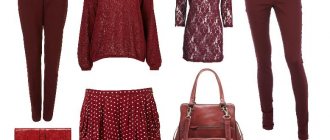Psychology of human color perception
All material objects in the world around us have their own characteristics, one of which is their color. It carries information necessary for communication and is perceived as a sensory impression. However, this perception is subjective, as it is formed only in the brain of the beholder. The sensation of color is created when waves of a certain length predominate in the color. For example, if the grass is green. This means that from the entire wave range it reflects the waves of the green part of the spectrum, and absorbs the rest. If the intensity of all waves is the same, then the color is perceived as white or gray. Non-emitting waves - black.
Color science (coloristics) is the science of color, studying its nature, characteristics, mixing, harmony, culture, human perception, etc. The first to create a color system was Leonardo Da Vinci, he identified 6 primary colors: white, black, yellow, red, blue, green. One of the aspects of coloristics is the study of human psychological perception of color. Why does red mean “stop” and green “go”. Color affects human physiology and psychology, so it can be used to evoke a particular emotion. So the red “stop” has a stimulating effect on the brain, since it has the longest wavelength, which requires more energy. With green or blue it’s the opposite. Soft, pastel colors evoke a feeling of calm when bright ones irritate.
The perception of color can often change depending on the psychophysiological state of a person. For example, they will decrease if the observer is tired, or, on the contrary, increase in case of danger. The table below provides a brief description of color associations and how color can affect a person.
Figure 1. Scheme of emotional perception of color shades
Table 1. Color associations, color perception
| Color | Associations | Impact |
| White | Purity, innocence, neutrality, lightness. | Increases space and, when used over a large area, creates a feeling of sterility. |
| Black | Mystery, anonymity, depth, mourning. | Conveys depth, can act depressively. |
| Yellow | Friendliness, cheerfulness, energy. | Helps solve problems and problems, stimulates the brain. |
| Red | Energy, speed, love, aggression, danger, fire, blood, war. | Improves mood, excites, leads. |
| Blue, light blue | Ice, sea, sky, depression, fidelity, peace, calm, stability, purity, safety, truth. | Coolness relieves inflammation, reduces anxiety levels; if exposed to it for too long, fatigue and tiredness occur. |
| Green | Nature, health, peace, envy, failure. | Calms the nervous system, reduces fatigue, and concentrates attention. |
| Orange | Warmth, confidence, light. | It has a beneficial effect on performance; prolonged exposure to orange may cause fatigue. |
| Brown | Earth, hearth, stability. | Creates an atmosphere of comfort and safety, conducive to communication. |
It is worth considering that in the culture of different peoples, the emotional and applied perception of color is very different, and is associated with a long historical tradition within the relatively isolated development of an ethnic group and religion. Hence the difference in perception, for example, of white and black colors (mourning or joy - depending on culture, religion).
Color is also very important in the interior. For example, red is good for a dining room, as it increases appetite, and in an office with a predominance of blue tones it will be better to focus attention.
Figure 2. The most suitable colors for different rooms
Colors can also visually change the perception of interior surfaces. In small rooms, it is recommended to make the walls in light colors in order to visually enlarge them. Bright or dark colors in this case will put pressure on a person; it is more rational to use them in large rooms or to highlight separate functional areas.
But a light floor, regardless of the room, will create the effect of less stability and reliability than a dark one.
The table below breaks down the emotional perception of individual colors of the planes of the room.
Table 2. Emotional perception of color in the interior
| Colors | Surfaces | ||
| Ceiling | Walls | Floor | |
| Beige, pink, light yellow | excite | Create a feeling of warmth and visually narrow the space | Causes a feeling of unsteadiness, fragility, unreliability |
| Red, brown, yellow-green | Depresses, makes you feel lonely | Narrow the space | Produces a feeling of stability and security |
| Blue, light green, light gray | Create a feeling of light and height | Spacious, cool | Anxiety, uncertainty, appear slippery, unstable |
| Grey, blue, dark green | Depressing | Causes a feeling of alienation, cools emotions | Creates a feeling of coolness and stability |
Knowledge about the perception of colors is actively used in marketing and advertising. When creating a logo for a particular product, it is necessary, first of all, to interest the future client. In addition, the designer must determine exactly what emotions the image he has developed will evoke in a person. For example, if we are creating a logo for dolls for girls, then pink will certainly be the winning color, as it combines sweetness and fairytale. Or a logo idea for a diner - yellow would be a good color option as it has a fun and friendly feel to it. Such a place will feel cozy and warm, and will undoubtedly provide a large flow of customers.
Figure 3. The influence of color on a person in marketing and advertising
Thus, we can conclude that colors not only make life brighter, but also influence our thoughts and actions, determining our mood. Knowledge about the perception of colors can be rationally used in marketing, design, psychology (to determine the type of person). Based on the above, let's summarize - flowers have their own system, which was consciously noticed by man many centuries ago. As a result, a whole science of color has emerged. From infancy, a person learns color perception, which subsequently depends on the personal characteristics of the individual. Culture plays an important role in the perception of color, as well as many other factors.
Color perception - how does it function?
Color perception is one of the functions of vision, thanks to which a person perceives the world in all its variety of colors and shades. The refractive system of the eye and the retina, on which light rays are collected after refraction by the lens and cornea, are responsible for image formation. The color of the picture is determined by the central point of the retina - the macula, or more precisely, the cones. These photoreceptors provide color vision and are involved in photopic (daytime) vision.
There are three primary colors in nature: red, green, blue. The entire variety of shades, of which there are several tens of thousands, is formed by mixing these three main tones. This theory was put forward by Lomonosov in 1756. T. Jung conducted his research in the same direction. Subsequently, the idea of three-component color perception was supplemented by G. Helmholtz and his students. There are three types of cones, each containing a specific pigment. In other words, the macula contains blue, red and green cones. In this case, color waves, regardless of their length (spectrum), immediately affect the entire cone apparatus. If there are any defects in it, the color perception will be incorrect. In this case, we are talking about color vision disorders. They are caused by pathologies of the optic nerve, retina, and nervous system.
Color vision disorders are rare. Approximately 8% of all men have congenital impairments of this visual function, but this does not mean that they cannot distinguish colors at all. In most cases, one of the spectra is not available to them. In women, problems with color perception are even less common (approximately 0.5% of cases). Color vision disorders can create some difficulties when choosing an activity. Information is often presented in the form of color signals - in transport, industry, agriculture and other areas.
Color techniques in psychotherapy.
We perceive generally accepted associations with different shades automatically. We say: turned purple with indignation, green with envy, black with melancholy, without even thinking about the meaning of these phrases. Although color shades have long been used for treatment and diagnosis in folk medicine. Thus, in Ayurveda, each color of the rainbow corresponds to one of the seven chakras that influence mental health. In Chinese medicine, each organ system is associated with its own element and its corresponding colors.
The relationship between emotions and color is used in various diagnostic and therapeutic techniques.
Luscher testing method.
Luscher's color psychodiagnostics makes it possible to determine the emotional state of the person being tested depending on his color preferences. The technique is based on the ranking of shades and the characteristics of subjective color perception. During testing, a person simply selects one shade from several offered. The better a person is able to abstract himself from thoughts and experiences, the more objective assessment of the personality he will receive in the end. The test is used for self-diagnosis, when hiring, in age and sociological studies.
Art therapy.
Art therapy is psychological work with drawing and color palette. This art therapy was created at the intersection of arts that are learned visually: painting, graphics, sculpture, design. Moreover, participation in therapeutic sessions does not require even minimal artistic abilities. Participants in the process simply get to know themselves.
Art therapy can be individual, but group work is considered more effective. Participants first act as creators: they create sculptures, paintings, and compositions. Then they become spectators, watching themselves and other participants from the outside. The session ends with a discussion of what the participants think the author put into his creation. The author himself shares his impressions of the work, his thoughts and emotions. Thanks to art therapy, awareness of one’s inner state comes, one’s attitude towards oneself can change, and self-esteem can improve.
Brief meaning of card positions
The color of the very first card in each row means the method of moving towards the goal, the state in which a person strives to achieve what he wants. For example, if the color blue comes first, then the main method is peace and tranquility.
The second position is the true goal, what a person strives for.
The third and fourth places reflect the situation and circumstances of the current period of life at the time of testing.
The fifth and sixth cards represent indifference; their meaning is not rejected, but has no place in the current situation.
The seventh and eighth are hostility, rejection, antipathy, forcedly suppressed needs.










